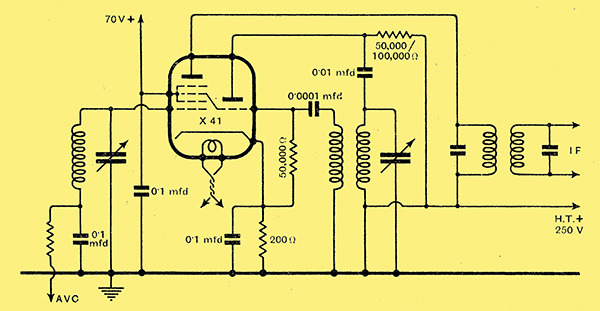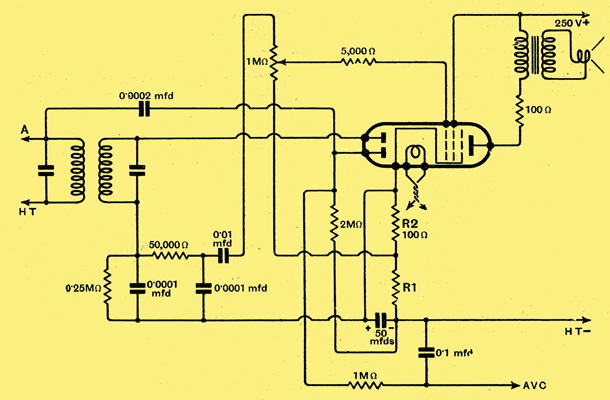|
A Brief Review of Some of the Latest Types
Development in valves is now steadily carried out by the various firms concerned, and the results are no longer kept back until the Olympia Exhibition, but are made evident in a steady stream of new types throughout the year. Consequently, although the specimens presented as brand new at the show may seem fewer than usual, the new valves produced during the radio year which has just ended are hardly less numerous than before.
A newcomer which happens to coincide with Olympia is the Marconi and Osram X41, and it is a valve which is of particular interest to the Short-Wave enthusiast. It is a triode-hexode frequency- changer, and on the medium and long waves its chief advantage over the heptode is its higher internal resistance. On short waves, however, two distinct merits are claimed for it the ease with which oscillation can be obtained and the absence of interaction between the signal and oscillator circuits. The hexode section has variable-mu characteristics and it is recommended that the triode section be used with a tuned-anode oscillator as shown in Fig. 1.

Fig. 1.- The recommended circuit connections for the triode-hexode frequency-changer are shown here. A tuned-anode oscillator circuit is advised for the best results.
The amplitude of oscillation should be adjusted to produce about 12 Volts on the triode grid, and this is checked most readily by measuring the current through the 50 kΩ grid leak; it should be about 0.2 mA/V, but the amplitude of oscillation is by no means critical and quite wide variations from the optimum affect the efficiency to only a small degree. The valve is for AC operation with a 4 Volt heater, but an AC/DC model, the X31, is also available, this, of course, has a 13 Volt 0.3 ampere heater.
The Hivac output tetrode, known as the Harries valve, can be substituted for an ordinary pentode without involving any changes in connections beyond seeing that the bias resistance has the correct value. The characteristics are claimed to be straighter than those of a pentode and the output for a given degree of distortion to be greater. The midget valves shown by this firm involve no special technique, for they can be treated in exactly the same way as the ordinary valves. Owing to their small size, however, they lend themselves well to the construction of portable apparatus. They are also available with Frequentite (Trade name of Soapstone ceramic -Ed.) bases and these specimens should appeal to those interested in short and ultra-short wave reception.

Fig. 2.- Typical connections for a duo-diode output pentode are given here. The AVC delay voltage is governed by the value of R1.
Another valve which is to be found in nearly every makerbs range is the duo-diode output pentode. A typical circuit is shown in Fig. 2, and it will be seen that it provides detection, delayed AVC, and an output of some 3.5 Watts. The values shown on this diagram vary somewhat with different makes, but they will permit a good performance with any valve. The only component with regard to which the makerbs instructions must strictly be adhered to is the bias resistance R2. The amount of delay on AVC is controlled by R1, and it will usually be satisfactory to make this resistance about 100 Ω. Typical valves of this type are the Marconi and Osram DN41, the Mazda PenDD4020 and AC2/PenDD, and the Ferranti PT4D, PTAD, and PTSD.
Universal type valves are employed chiefly in AC/DC sets at the present time, but since the majority of them have 13 Volt heaters, they are suitable for car sets and are often employed for this purpose. Output valves and rectifiers of the true AC/DC type usually require a higher heater voltage, so that many makers duplicate these types in different heater ratings. Thus the Ferranti PTSD has a 26 Volt 0.3 ampere heater for AC/DC sets, while its counterpart for car radio, the PTAD, has a 13 Volt 0.6 ampere heater.
The question of obtaining large power output has not been ignored during the past year, and the 'low-loading' system enables 30 Watts to be obtained from a pair of PX25A valves a pair of the new DA30 valves will give 45 Watts in this system with only 500 Volts HT. At the other end of the scale, the battery user has the choice of QPP and Class B. Mullard have the PM2B Class B valve and the QP22A double-pentode which has a 9-pin base and gives an output of over 1 Watt. Mazda have also a QPP valve of this type, the QP24, and two Class B models, while Cossor have a Class B type rated for 2 Watts output. The Marconi and Osram QP21 valves have 7 pin bases, as also have their Class B types.
Special purpose valves are beginning to make an appearance. These are not intended for general use, but for cases where specially stringent requirements render them advisable. A case in point is the first valve of a microphone pre-amplifier. The degree of amplification needed with good-quality microphones is often so high that it is difficult to obtain good results with ordinary valves. Not only must the insulation of the grid be very good but the inter-electrode capacities must be low and the valve free from microphony and other forms of noise. The Osram A537 is designed for cases such as these and it is claimed to be particularly silent in operation. It is a triode with a mutual conductance of 1.5 mA/V, and it is fitted with a top-cap for the grid. Steatite (Soapstone -Ed.) insulation is used. Although it is indirectly heated, battery operation is recommended for the most silent results.
|